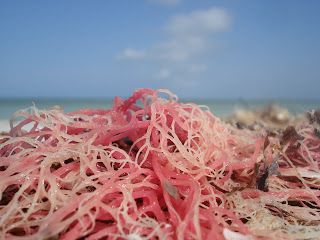 Sea wrack. What the heck is sea wrack? Most beach goers avoid it like the toxic red tide. Sunbathers and shell collectors complain that it is smelly and want to see it raked up and removed.
Sea wrack. What the heck is sea wrack? Most beach goers avoid it like the toxic red tide. Sunbathers and shell collectors complain that it is smelly and want to see it raked up and removed.
That annoying scraggly line of debris along the high-tide mark, sea wrack, is an accumulation of seagrasses, algae, and animal remains which lie baking in the sun. This pile-up is a prime feeding place, alive with swarms of tiny amphipods, insects and larvae feeding on the weeds and stranded animal remains. Crabs and shorebirds forage here. I forage in the sea wrack too.
Yea, yea. I could walk the beach here at Cayo Costa, one of the best for shelling in the world, and find angel wings, sand dollars, coquinas and a godzillian more shells in a short walk, but look what I found in less than 10 linear feet of sea wrack. I'm not going to take them home and display them on a shelf or put them in a little basket in the bathroom. No, no. My little treasures are not going to collect dust. They will though, collect sun rays and sea spray until they return to dust. This is a 10 inch conch shell encrusted with barnacles and nearly completely covered with something that looks like a white soft coral.
This is a 10 inch conch shell encrusted with barnacles and nearly completely covered with something that looks like a white soft coral. Isn't this color beautiful? I did some work with a naturalist who collects algae like this to make colorful sea art at home.
Isn't this color beautiful? I did some work with a naturalist who collects algae like this to make colorful sea art at home. This coil looks like a snake skin. You can find dozens of these whelk (a gastropod similar to conch) egg cases on the beach or shores of the lagoon.
This coil looks like a snake skin. You can find dozens of these whelk (a gastropod similar to conch) egg cases on the beach or shores of the lagoon.
Next time you are at the beach, take a closer look through the sea urchins (below) and sea wrack. You'll find many fascinating things and can observe a world of activity within the debris. And it doesn't smell as bad as dumpster diving, I promise.
skip to main |
skip to sidebar

Getting Cheryl Out There

Getting You Out There. Integrating the Natural World with Fitness, Water Gardening, and Fun.

Getting Cheryl Out There
About Me
- Water's Edge
- I spent 25 years as a respiratory therapist and at age 50 switched careers in order to spend more time outdoors and renew a dwindling spirit. Reviving my interest in the environment and my college degree in biology, I started and have operated a watergardening business since 2000 and became a certified interpretive guide with the Metroparks of the Toledo Area leading nature walks, backpacking trips for women, and sustainability projects. I have 2 children, Devin (age 25) and Livia (age 30) who were homeschooled until junior high. My husband, Dan, has been my adventure inspiration, both in travel and raising children.
Labels
- adventure (12)
- fitness (15)
- girlfullness (3)
- kayaking (6)
- mini-adventures (1)
- Mini-adventures (3)
- nature (22)
- out is in (10)
- water gardening (3)

